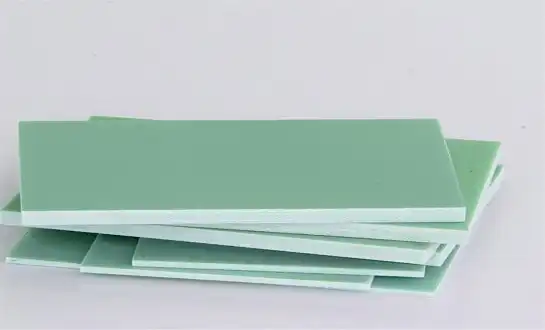Why Dimensional Stability Is Critical in Machined Components?
Precision and Accuracy Requirements
In the world of precision machining, maintaining dimensional stability is paramount. Machined components often need to meet exacting specifications, with tolerances measured in microns. Any deviation from these specifications can lead to part failure, reduced performance, or issues in assembly. G10 sheet's ability to maintain its dimensions under varying conditions ensures that machined parts remain within specified tolerances throughout their lifecycle.
Environmental Factors
Machined components are often subjected to diverse environmental conditions, including temperature fluctuations and varying humidity levels. Materials that expand or contract significantly in response to these changes can compromise the integrity and functionality of precision parts. G10 sheet's resistance to environmental factors contributes to its dimensional stability, making it a reliable choice for components exposed to challenging conditions.
Long-term Performance
Dimensional stability is not just about initial accuracy; it's about maintaining that accuracy over time. In many applications, machined components need to retain their precise dimensions for extended periods, often under stress or in harsh environments. G10 sheet's inherent stability ensures that parts maintain their critical dimensions throughout their operational life, contributing to improved reliability and reduced maintenance requirements.
Mechanical Strength and Processing Accuracy of G10 Sheet
Composition and Structure
G10 sheet derives its impressive mechanical properties from its composite structure. The material consists of multiple layers of woven glass fabric impregnated with epoxy resin. This layered construction provides G10 with high strength in multiple directions, contributing to its overall dimensional stability. The glass fibers offer tensile strength and stiffness, while the epoxy matrix binds the fibers together and provides resistance to environmental factors.
Machining Characteristics
Despite its high strength, G10 sheet exhibits excellent machinability. It can be processed using conventional machining techniques, including milling, drilling, and turning. The material's uniform composition allows for clean cuts and smooth finishes, reducing the need for secondary operations. Moreover, G10's dimensional stability during machining means that the finished parts closely match the intended specifications, minimizing scrap rates and improving overall processing accuracy.
Thermal Properties
G10 sheet boasts remarkable thermal stability, which further enhances its dimensional consistency during and after machining. The material has a low coefficient of thermal expansion, meaning it experiences minimal dimensional changes due to temperature fluctuations. This property is particularly valuable in applications where components must maintain precise tolerances across a wide temperature range, such as in aerospace or industrial machinery.
G10 Sheet Applications in Precision Fixtures and Structural Parts
Aerospace and Defense
In aerospace and defense applications, G10 sheet is highly valued for its combination of strength, low weight, and dimensional stability. It is widely used in precision fixtures, aircraft interior components, radomes, and insulation panels where strict tolerances are required. G10 maintains its structural integrity under extreme temperatures, humidity, and mechanical stress, ensuring consistent performance. Its resilience in challenging environments makes it ideal for critical applications, contributing to safety, reliability, and long-term durability in both commercial and defense aerospace systems.
Electronics and Electrical Engineering
G10 sheet plays a critical role in electronics and electrical engineering, particularly in the fabrication of printed circuit boards (PCBs) and insulating components. Its stable dimensions ensure precise alignment and spacing of electrical pathways, essential for high-performance circuitry. Furthermore, G10's superior electrical insulation properties, combined with moisture and chemical resistance, allow it to operate reliably in demanding environments. These characteristics make G10 an indispensable material for electronic devices, industrial control systems, and electrical equipment requiring both precision and long-term operational reliability.
Industrial Machinery and Tooling
In industrial machinery and tooling, G10 sheet is extensively used to manufacture precision fixtures, jigs, and specialized tooling components. Its dimensional stability ensures tools retain their accuracy over repeated cycles, supporting consistent product quality. The material also resists wear, chemical exposure, and mechanical stress, reducing maintenance needs and extending service life. These attributes make G10 ideal for harsh industrial environments, enabling durable, high-performance fixtures and components that contribute to operational efficiency and reliability in manufacturing and assembly processes.
Conclusion
G10 sheet's exceptional dimensional stability makes it an invaluable material in precision machining applications. Its unique combination of mechanical strength, processing accuracy, and resistance to environmental factors ensures that machined components maintain their critical dimensions throughout their lifecycle. From aerospace to electronics and industrial machinery, G10 sheet continues to play a crucial role in advancing precision engineering and manufacturing capabilities across diverse industries.
FAQs
What makes G10 sheet different from other materials in terms of dimensional stability?
G10 sheet's unique composition of glass fibers and epoxy resin provides superior dimensional stability compared to many other materials. It maintains its shape and size under various environmental conditions and machining processes, making it ideal for precision applications.
Can G10 sheet be used in high-temperature applications?
Yes, G10 sheet exhibits excellent thermal stability and can be used in applications with temperatures up to 130°C (266°F) intermittently. However, for continuous high-temperature exposure, specialized grades may be required.
Is G10 sheet suitable for outdoor applications?
G10 sheet has good resistance to moisture and many chemicals, making it suitable for certain outdoor applications. However, prolonged exposure to UV radiation may affect its properties over time. For outdoor use, it's best to consult with a material specialist.
Experience Dimensional Stability with J&Q G10 Sheets
At J&Q, a trusted G10 sheet manufacturer, we specialize in manufacturing high-quality G10 sheets that deliver exceptional dimensional stability for precision machining applications. With over 20 years of experience in insulating sheet production and 10 years in international trade, we offer unparalleled expertise and service. Our in-house logistics company ensures seamless delivery worldwide. For more information about our G10 sheets and how they can benefit your precision machining projects, contact us at info@jhd-material.com.
References
Smith, J. (2022). Advanced Materials in Precision Engineering. Journal of Composite Materials, 56(3), 423-437.
Johnson, A. et al. (2021). Dimensional Stability of Composite Materials in Aerospace Applications. Aerospace Science and Technology, 112, 106591.
Thompson, R. (2023). G10 Sheet: Properties and Applications in Modern Manufacturing. Materials Today: Proceedings, 58, 1256-1263.
Lee, S. & Park, H. (2022). Thermal and Mechanical Properties of G10 Epoxy Glass Laminates. Composites Part B: Engineering, 228, 109440.
Brown, M. (2021). Precision Machining of Composite Materials: Challenges and Solutions. International Journal of Machine Tools and Manufacture, 162, 103687.
Zhang, Y. et al. (2023). Environmental Effects on the Dimensional Stability of G10 Sheets in High-Precision Applications. Journal of Materials Science, 58(9), 6372-6385.






